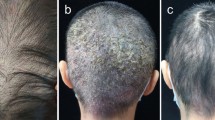Abstract
White piedra is a superficial mycosis characterized by soft, white-to-tan, irregular nodules attached to the hair shafts. A 36-year-old man presented with small lumps in his pubic hair, without any other symptoms. The clinical features were suggestive of trichobacteriosis. Pathology analysis of the infected hair revealed that the concretions surrounding the hair shaft were full of fungal elements, parts of which had invaded into the cuticle. Culture on Sabouraud dextrose agar grew creamy, yellow–white colonies identified as Trichosporon inkin by the sequence of the nuclear ribosomal intergenic spacer region. The condition was treated by shaving the pubic hair and administering antifungal therapy (oral itraconazole and topical ketoconazole).


Similar content being viewed by others
References
Shivaprakash M, Singh G, Gupta P, Dhaliwal M, Kanwar A, Chakrabarti A. Extensive white piedra of the scalp caused by Trichosporon inkin: a case report and review of literature. Mycopathologia. 2011;172:481–6.
Goldberg L, Wise E, Miller N. White piedra in a northern climate caused by Trichosporon inkin: a report of two cases. Br J Dermatol. 2015;173:866–8.
Liao W, Xue Y, Chen P, Xu DQ, Zhang JZ, Li SQ, Chen QT. Cepholosporium acremonium: a new strain of fungus causing white piedra. China Med J. 1991;104:425–7 (in Chinese).
Zhuang K, Ran X, Lei S, Zhang C, Lama J, Ran Y. Scanning and transmission electron microscopic observation of the parasitic form of Trichophyton violaceum in the infected hair from tinea capitis. Scanning. 2014;36:465–70.
Zhang H, Ran Y, Liu Y, Zhang R, Lin X, Yan W, Dai Y. Arthroderma vanbreuseghemii infection in three family members with kerion and tinea corporis. Med Mycol. 2009;47:539–44.
Youker S, Andreozzi R, Appelbaum P, Credito K, Miller J. White piedra: further evidence of a synergistic infection. J Am Acad Dermatol. 2003;49:746–9.
Colombo A, Padovan A, Chaves G. Current knowledge of Trichosporon spp. and trichosporonosis. Clin Microbiol Rev. 2011;24:628–700.
Magalhães AR, Mondino SS, Silva M, Nishikawa MM. Morphological and biochemical characterization of the aetiological agents of white piedra. Mem Inst Oswaldo Cruz. 2008;103:786–90.
Iturrieta-González IA, Padovan AC, Bizerra FC, Hahn RC, Colombo AL. Multiple species of Trichosporon produce biofilms highly resistant to triazoles and amphotericin B. PLoS ONE. 2014;9:e109553.
Kiken DA, Sekaran A, Antaya RJ, Davis A, Imaeda S, Silverberg NB. White piedra in children. J Am Acad Dermatol. 2006;55:956–61.
Fischman O, Bezerra FC, Francisco EC, et al. Trichosporon inkin: an uncommon agent of scalp white piedra. Report of four cases in Brazilian children. Mycopathologia. 2014;178:85–9.
Zhang E, Sugita T, Tsuboi R, Yamazaki T, Makimura K. The opportunistic yeast pathogen Trichosporon asahii colonizes the skin of healthy individuals: analysis of 380 healthy individuals by age and gender using a nested polymerase chain reaction assay. Microbiol Immunol. 2011;55:483–8.
Inácio CP, Rocha AP, Barbosa Rdo N, Oliveira NT, Silva JC, de Lima-Neto RG, Macêdo DP, Neves RP. Experimental white piedra: a robust approach to ultrastructural analysis, scanning electron microscopy and etiological discoveries. Exp Dermatol. 2016;25:79–81.
Bentubo H, Gompertz O. Effects of temperature and incubation time on the in vitro expression of proteases, phospholipases, lipases and DNases by different species of Trichosporon. SpringerPlus. 2014;3:377.
Tendolkar U, Shinde A, Baveja S, Dhurat R, Phiske M. Trichosporon inkin and Trichosporon mucoides as unusual causes of white piedra of scalp hair. Indian J Dermatol Venereol Leprol. 2014;80:324–7.
Ji J, Park T, Lee H. The ethnic differences of the damage of hair and integral hair lipid after ultra violet radiation. Ann Dermatol. 2013;25:54–60.
Schwartz RA. Superficial fungal infections. Lancet. 2004;364:1173–82.
Alexandro B, Denisse V, Leonel F, Javier A, Rosa M. Trichomycosis (Trichobacteriosis): clinical and microbiological experience with 56 cases. Int J Trichol. 2013;5:12–6.
García-Martos P, Ruiz-Henestrosa JR, Pérez-Requena J, Marín P, Mira J, Calap J. Hyperhidrosis and multiple nodules in the hairs of the axilla. Enferm Infecc Microbiol Clin. 2001;19:177–8.
Salim G, Zahra MF. Trichobacteriosis: contribution of dermoscopy. Dermatol Online J. 2014;20.
Guiotoku MM, Ramos PM, Miot HA, Marques SA. Trichobacteriosis: case report and dermoscopic study. An Bras Dermatol. 2012;87:315–6.
Acknowledgments
This work is partly supported by Project 81472539 of the National Natural Science Foundation of China.
Author information
Authors and Affiliations
Corresponding author
Ethics declarations
Conflict of interest
The authors declare no conflicts of interest.
Additional information
Kaiwen Zhuang and Xin Ran have contributed equally.
Rights and permissions
About this article
Cite this article
Zhuang, K., Ran, X., Dai, Y. et al. An Unusual Case of White Piedra Due to Trichosporon inkin Mimicking Trichobacteriosis. Mycopathologia 181, 909–914 (2016). https://doi.org/10.1007/s11046-016-0049-9
Received:
Accepted:
Published:
Issue Date:
DOI: https://doi.org/10.1007/s11046-016-0049-9




